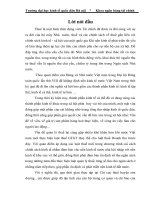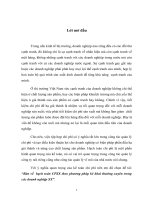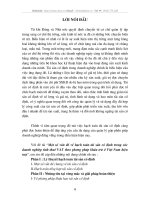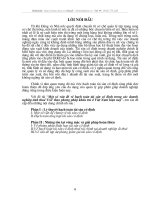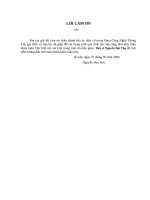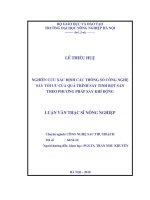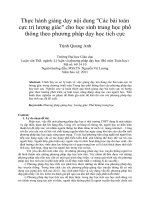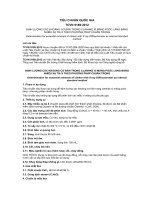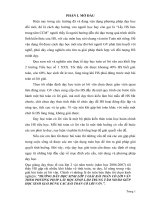Steps of isokinetic stack sampling _ Các bước quan trắc khí thải theo phương pháp đẳng tốc
Bạn đang xem bản rút gọn của tài liệu. Xem và tải ngay bản đầy đủ của tài liệu tại đây (1011.73 KB, 18 trang )
11 STEPS OF STACK SAMPLING
Intro
11 STEPS OF STACK SAMPLING
1.
DEFINE THE PROBLEM - WHY DO THE TEST?
2.
OBTAIN COOPERATION
3.
RESEARCH LITERATURE
4.
PRE-SURVEY AND WRITE TEST PROTOCOL
5.
PREPARE EQUIPMENT
6.
ON-SITE - PREPARATION AND PRELIMINARY TESTING FOR ISOKINETIC
7.
ON-SITE - STACK SAMPLING (ISOKINETIC)
8.
SAMPLE RECOVERY
9.
DEMOBILIZATION AND TRANSPORT SAMPLES
10. ANALYZE SAMPLES (Particulate Matter from isokinetic sampling)
11. WRITE REPORT
Filename: Steps of Isokinetic Stack Sampling.docx
Date: June 2012
Page | 1 of 18
11 STEPS OF STACK SAMPLING
Intro
WHERE TO FIND INFORMATION ABOUT STACK SAMPLING
USA :
/> />
GENERAL TRAINING ON AIR EMISSIONS : />
SOME EQUIPMENT VENDORS :
/> /> /> /> />
VIETNAM QCVN:
/>
ISO : />
Filename: Steps of Isokinetic Stack Sampling.docx
Date: June 2012
Page | 2 of 18
DEFINE THE PROBLEM - WHY DO THE TEST?
STEP
1
1. DEFINE THE PROBLEM - WHY DO THE TEST?
International Good Practices
A- Determine Necessity of a Source Test
a) Decide on data required
b) Determine that source test will give this data
c) Analyze cost
B- State Source Test Objectives
a) Process Evaluation
b) Process Design Data
c) Regulatory Compliance
VPEG advice
Review QCVN and TCVN to determine types of pollutants to sample for
If air pollution control equipment is in place, try test inlet and outlet for removal efficiency (%)
As much as possible, include oxygen (O2) and flow rate (m3/h) measurements
Consider using emission factors instead of stack testing
Useful links
QCVN : />Process information and Emission Factors: />
Filename: Steps of Isokinetic Stack Sampling.docx
Date: June 2012
Page | 3 of 18
OBTAIN COOPERATION
STEP
2
2. OBTAIN COOPERATION
International Good Practices
A- Contact Factory
a) Contact Factory Manager
b) Contact Factory Technical staff
c) Obtain verbal approval for testing
B- Contact Regulatory Agency
a) Advise agency staff in charge of project or factory
C- Contact Process or Air Pollution Control Equipment Supplier
a) When applicable
VPEG advice
In Vietnam, often need official letter to have access to factory
In Vietnam, if factory not willing to collaborate, maybe not necessary to go through next steps!
Useful links
n/a
Filename: Steps of Isokinetic Stack Sampling.docx
Date: June 2012
Page | 4 of 18
RESEARCH LITERATURE
STEP
3
3. RESEARCH LITERATURE
International Good Practices
A- Research for:
a)
b)
c)
d)
e)
Basic Process Operation
Type of pollutant emitted from process
Physical State at Source Conditions
Probable Point of Emissions from Process
If available, read sampling reports from other similar process: problems to expect; estimate of H2O
vapor and stack temperature
VPEG advice
Don’t limit yourself to stack from furnaces
Useful links
Process information and Emission Factors: />
Filename: Steps of Isokinetic Stack Sampling.docx
Date: June 2012
Page | 5 of 18
PRE-SURVEY AND WRITE TEST PROTOCOL
STEP
4
4. PRE-SURVEY AND WRITE TEST PROTOCOL
International Good Practices
A- Pre-Survey at the factory
a)
b)
c)
d)
e)
f)
g)
h)
i)
j)
Contact Factory Personnel
Inform Factory Personnel of testing Objectives and Requirements for Completion
Review Process with Factory Personnel
Identify Adequate Sampling Locations and Access
Evaluate Safety
Determine sampling point location. Use EPA Method 1 and 2 if flow rate must be measured
Locate Electrical Power Supply to Site
Drawings, photographs of sampling site
Locate restrooms and food at factory
Note any special equipment needed
B- Test Protocol
a)
b)
c)
d)
e)
f)
g)
h)
i)
Develop Sampling Approach
Select Equipment to meet Test Objectives
Select Analytical Method
Evaluate Possible Errors and Biases and correct sampling approach
Determine Manpower Needed for Test
Determine Time Required for Test with Margin for Breakdowns
Write Test Protocol
Submit Test Protocol to Factory and Regulatory Agency
Set Test Date and Duration
VPEG advice
Bring Field Practice Packet Provided by VPEG
Know about the process before meeting factory personnel, they will appreciate your knowledge
If source has been tested before, maybe no need to do pre-survey
Useful links
Content of Test Protocol by EPA: />
Field Practice Packet by VPEG
Field Practice Packet
Methods 1 to 4.pdf
Example of Test Protocol for Vietnam:
Filename: Steps of Isokinetic Stack Sampling.docx
Date: June 2012
Test Protocol
Example.doc
Page | 6 of 18
PREPARE EQUIPMENT
STEP
5
5. PREPARE EQUIPMENT
International Good Practices (* except for portable analyzer section)
A- Prepare Equipment
a)
b)
c)
d)
e)
Prepare Packing List (see example below)
Prepare Filters and Reagents
Calibrate Equipment
Prepare Portable Analyzer
Include Spare Parts if possible
B- Prepare Filters and Reagents
a)
b)
c)
d)
e)
f)
Identify filters correctly and permanently (use petri dish)
Dessicate filters to constant weight for at least 24 hours
Record filter weights (±0.1 mg) in permanent laboratory file
Prepare sufficient deionized water to place in impingers
Prepare sufficient silica gel
Prepare sufficient acetone for nozzle and probe rinsings
C- Equipment to Calibrate (when doing isokinetic sampling)
a)
b)
c)
d)
e)
f)
g)
Dry Gas Meter
Determine console ΔH@
Nozzles
Thermometers and Thermocouples
Pressure Gauges
Pitot Tubes and probes
Portable Analyzer for gas composition
D- Prepare Portable Analyzer*
a)
b)
c)
d)
e)
Ensure Calibration Certificate of portable analyzer is valid and recent
Battery full
Leak Check is acceptable (follow procedure from user guide)
All cells have sufficient operating time left (see Menu option of analyzer if available)
Ensure oxygen cell works fine
VPEG advice
Useful links
Calibration of equipment may not be possible at this time in Vietnam
Equipment Preparation Checklist by VPEG:
Filename: Steps of Isokinetic Stack Sampling.docx
Date: June 2012
Equipment Checklist
for Isokinetic Sampling.pdf
Page | 7 of 18
ON-SITE - PREPARATION AND PRELIMINARY TESTING FOR ISOKINETIC
STEP
6
6. ON-SITE - PREPARATION AND PRELIMINARY TESTING FOR ISOKINETIC
International Good Practices
A- Before arrival on-site
a) Confirm Test Date and Process Operation
b) Review Test Plan with all concerned
B- Arrival on-site
a)
b)
c)
d)
e)
f)
g)
Notify Plant and Regulatory Agency Personnel
Check weather forecast
Confirm Process Operation Parameters in Control Room
Verify sampling site has been prepared correctly/completely by factory
Carry Equipment to Sampling Site
Locate Electrical Connections
Prepare field laboratory and equipment
C- Preliminary Testing
a)
b)
c)
d)
Measure Stack Diameter
Measure Sampling port length and diameter
Quick Measure of O2, CO2 and CO to determine approximate molecular weight of stack gas
Determine approximate moisture content of stack gas (±3% v/v), using one of the following methods:
- Use previous test data if available, or
- Saturation temperature chart, if after wet scrubber, or
- Wet/dry bulb temperature and chart, or
- Perform a 20-30 minute moisture test with condensation technique (impingers)
e) Use pitot tube to traverse duct for velocity profile (quick). Record several DP, temperature and static
pressure.
f) Record barometric pressure
D- Determine Nozzle Size
a) Determine Ideal Nozzle size based on data from preliminary testing. Use one of the following:
- Computer program for nozzle size, or
- Console module internal program (for Tecora), or
- Formula and hand calculations, or
- Sliding rule or nomograph, or
- Programmed Calculator
b) Based on ideal nozzle size, select most appropriate from available nozzle sizes
c) If you select nozzle too large, console pump may not be strong enough to pull for the entire test
d) If you select nozzle too small, sample volume will be small
Filename: Steps of Isokinetic Stack Sampling.docx
Date: June 2012
Page | 8 of 18
ON-SITE - PREPARATION AND PRELIMINARY TESTING FOR ISOKINETIC
STEP
6
E- Determine Sample Points Position
a) Calculate sample point position based on EPA Methods 1 and 2, using one of the following methods:
- Use Manual Calculations, or
- Use calculator, or
- Use computer program
b) Mark sampling probe using measuring tape and permanent marker or heat tape
VPEG advice
Useful tools
Manual Calculation Example for Isokinetic Sampling by VPEG:
Blank sheets for isokinetic Sampling
Sample Point position Example
Isokinetic Blank
Calculations and Field Sheets.pdf
Examples and
Homework B&W.pdf
Sample Point position Blank sheets
Field Practice Packet
Methods 1 to 4.pdf
Sample Point Position and Moisture Excel sheet
Filename: Steps of Isokinetic Stack Sampling.docx
Date: June 2012
Isokinetic
Calculations Example - ABC Steel Co (B&W).pdf
ABC Steel Flow and
H2O Calcs.xls
Page | 9 of 18
ON-SITE - STACK SAMPLING (ISOKINETIC)
STEP
7
7. ON-SITE - STACK SAMPLING (ISOKINETIC)
International Good Practices
A- Assemble Sampling Train (4 impingers)
a)
b)
c)
d)
e)
f)
Impinger 1 and 2: Place 100 ml of DI water each. Weigh each impinger. Record on datasheet.
Impinger 3: Empty. Weigh impinger. Record on datasheet.
Impinger 4: Place 200-300 grams of Silica Gel (fresh). Weigh impinger. Record on datasheet.
Install nozzle on marked probe
Install pre-weighed and clearly identified filter in filter holder. Use tweezers. Record filter ID on data
sheet.
Connect everything, place impingers in ice box with ice, turn on all heaters.
B- Leak Check Pitot Tubes
a) blow through the pitot impact opening until ≥ 7.6 cm H2O velocity pressure registers on the
manometer
b) then, close off the impact opening
c) the pressure shall remain stable for at least 15 seconds
d) do the same for the static pressure side, except using suction to obtain the minimum of 7.6 cm H2O
e) record pitot tube leak check results on datasheet
C- Calculations and Datasheet Preparation
a)
b)
c)
d)
Calculate K factor for adjustments of DP and DH
Record all available information on test datasheet
Prepare datasheet for test
With factory staff, ensure process operation is representative and normal
D- Leak Check Sampling Train
a)
b)
c)
d)
e)
f)
Plug the nozzle with a finger
Open the bypass valve
Close the coarse adjust valve
Start the pump
Slowly close the bypass valve until 30 inHg or 760 mmHg is reached
DO NOT REVERSE direction of bypass valve; this will cause water to backup into the filter holder.
If desired vacuum is exceeded leak check at this higher value
g) Allow stabilization, then record leak rate using stopwatch. Leak check ≤ 0.57 L/min.
h) DO NOT STOP THE PUMP NOW
i) Slowly remove your finger from the nozzle. When finger removed, turn off the pump.
j) If leak check more than 0.57 L/min, find and fix leak and redo leak check.
k) Record leak check result on datasheet
Filename: Steps of Isokinetic Stack Sampling.docx
Date: June 2012
Page | 10 of 18
ON-SITE - STACK SAMPLING (ISOKINETIC)
STEP
7
E- Start and Conduct Source Test
a)
b)
c)
d)
Record initial gas meter reading
Level and zero manometer
Clean the port holes
Verify all ok:
- Probe and filter box heaters (≥ 120°C)
- pitot tube aligned with nozzle.
- aligned for gas stream direction
- sufficient water/ice in ice box
e) Position the nozzle at first traverse point
f) When probe is in position block off the opening around probe/port hole
g) Record start time
h) Record gas DP (velocity)
i) Determine DH desired
j) Turn ON pump
k) Adjust DH for isokinetic conditions
l) Record all required data on datasheet
m) Repeat for all points on traverse
F- To do during the test
a)
b)
c)
d)
e)
f)
g)
h)
i)
j)
Maintain isokinetic DH at all times
Take samples for molecular weight determination (O2, CO2, CO)
Use integrated orsat pump if available
Use portable analyzer and record during sufficient length of time
Take grab samples in bag and analyze with portable analyzer
Add ice to maintain ≤ 20°C at outlet of last impinger
Monitor process rate. Take control room data if necessary.
Ensure you record all data on datasheet (use pen, not pencil)
Periodically check manometer zero and level
Probe and heater ≥ 120°C.
Record static pressure at least once per traverse
Be careful during traverse change
Do not bump the nozzle against the stack wall or the port hole wall
G- Finish the test
a)
b)
c)
d)
e)
f)
g)
h)
Turn off the coarse adjust valve
Remove the probe from the stack
Turn off the pump and heaters
Record the final gas meter reading and time
Allow probe/nozzle to cool
Wipe-off external PM from the nozzle and cap
Leak check the sampling train (as per procedure above). Record on datasheet.
Leak check the pitot tube (as per procedure above). Record on datasheet.
Filename: Steps of Isokinetic Stack Sampling.docx
Date: June 2012
Page | 11 of 18
ON-SITE - STACK SAMPLING (ISOKINETIC)
Useful tools
Manual Calculation Example for Isokinetic Sampling by VPEG:
Blank sheets for isokinetic Sampling
Filename: Steps of Isokinetic Stack Sampling.docx
Date: June 2012
STEP
7
Isokinetic
Calculations Example - ABC Steel Co (B&W).pdf
Isokinetic Blank
Calculations and Field Sheets.pdf
Page | 12 of 18
SAMPLE RECOVERY
STEP
8
8. SAMPLE RECOVERY
International Good Practices
A- Disassemble Sampling Train
a) Disconnect the probe from the Cyclone Bypass inlet and cover both ends
b) Disconnect the Filter Holder from the “L” Adapter and cap off the Filter Holder
c) Disconnect the Umbilical Cable from the Sample Box and cover the last impinger outlet and first impinger
inlet.
d) Disconnect the Cold Box from the Hot Box
e) The Probe/nozzle Assembly, Filter Holder, and impinger case are ready for sample recovery
f) Transfer the probe and filter-impinger assembly to a cleanup area that is clean and protected from the
wind.
B- Sample Recovery
a)
Container No. 1 – Filter
- Using a pair of tweezers and/or clean disposable surgical gloves, carefully remove filter from the Filter
Holder, and place it in its identified petri dish container. If necessary, fold the filter such that the
particulate matter cake is inside the fold.
- Using a nylon bristle brush and/or a sharp-edged blade, carefully transfer to the petri dish any PM
and/or remaining pieces of filter or filter fibers that adhere to the filter support or gasket.
b) Container No. 2 – Acetone Rinses. Recover any particulate matter from the internal surfaces of the Probe
Nozzle, swaged union fitting, probe liner (use a glass funnel to aid in transferring liquid washed to the
container), front half of the Filter Holder, and (if applicable) the cyclone, and recover all rinses in a single
glass container as follows:
-
c)
Rinse front half of the filter holder with acetone, brush with small nylon bristle brush, and rinse with
acetone until there are no visible particles. Make a final acetone rinse.
For probe liner, repeat rinse, brush, rinse sequence at least three times for glass liners, and six times
for metal liners.
For Probe Nozzle, use the nylon nozzle brush and follow the same sequence of rinse, brush, rinse as
for the probe liner.
After completing the rinse, tighten the lid on the sample container. Mark the height of the fluid level.
Label the container.
Silica Gel Impinger. Record final weight (±0.5 g) on datasheet.
d) Impingers 1, 2 and 3. Record final weight (±0.5 g) on datasheet. Discard water unless further analysis
required.
Filename: Steps of Isokinetic Stack Sampling.docx
Date: June 2012
Page | 13 of 18
SAMPLE RECOVERY
STEP
8
C- Results Compilation before next test
a)
b)
c)
d)
e)
At the conclusion of each sampling run, it is prudent to calculate the stack gas moisture (for the next
sampling run) as well as the average isokinetic rate.
Use a computer program to do these calculations
Make any necessary adjustments before starting the next test
Before next test, check process operating conditions are still representative of normal
Ensure datasheets are completed
Variations and Alternatives
1.
Instead of trying to catch the probe rinse with a glass funnel and sample container (likely step for sample
loss), clamp an Erlenmeyer flask outfitted with female ball joint on the probe liner ball joint and conduct the
probe rinse procedure. If the probe is short, one person can perform the brushing and rinsing.
2.
Acceptable alternatives to glass probe liners are metal liners, for example, 316 stainless steel, Inconel or
other corrosion resistant metals made of seamless tubing. These can be useful for cross-sections over 3 m
(10 ft.) in diameter. Whenever practical, make every effort to use borosilicate glass or quartz probe liners.
Metal liners will bias particulate matter results high.
3.
For large stacks, consider sampling from opposite sides of the stack to reduce the length of probe.
4.
Use either borosilicate or quartz glass probe liners for stack temperatures up to 480° to 900°C (900 –
1,650°F). The softening temperature for borosilicate glass is 820°C (1,508°F), and for quartz it is 1,500°C
(2,732°F).
5.
Rather than labeling filters, label the shipping containers (glass or plastic petri dishes), and keep the filters
in these containers at all times except during sampling and weighing.
6.
Use more silica gel in impinger 4, if necessary, but ensure that there is no entrainment or loss during
sampling. Hint: Loosely place cotton balls or glass wool in the neck of the silica gel impinger outlet stem.
7.
If a different type of condenser (other than impingers) is used, measure the amount of moisture condensed
either volumetrically or gravimetrically.
8.
For moisture content, measure the impinger contents volumetrically or gravimetrically before and after a
sampling run. Use a pre-weighed amount of silica gel in a shipping container, then empty the silica gel after
the run back into the container for weighing at another time.
9.
If the total particulate catch is expected to exceed 100 mg or more or when water droplets are present in
the stack gas use a Glass Cyclone between the probe and Filter Holder.
10. If high pressure drops across the filter (high vacuum on the gauge) causing difficulty in maintaining
isokinetic sampling, replace the filter. Suggestion: Use another filter assembly rather than changing the
filter itself. Before installing a new filter, conduct a leak-check. Add the filter assembly catches for the total
particulate matter weight.
11. Use a single train for the entire sampling run, except when simultaneous sampling is required in two or
more separate ducts or at two or more different locations within the same duct, or in cases where
Filename: Steps of Isokinetic Stack Sampling.docx
Date: June 2012
Page | 14 of 18
SAMPLE RECOVERY
STEP
8
equipment failure necessitates a change in trains. In all other situations, obtain approval from the
regulatory agency before using two or more trains.
12. When two or more trains are used, analyze separately the front-half and (if applicable) impinger catches
from each train unless identical nozzle sizes were used on all trains. In this case, the front-half catches may
be combined (as may the impinger catches) and one analysis of front-half catch and one analysis of
impinger catch may be performed. Consult with the regulatory agency for details concerning the calculation
of results when two or more trains are used.
13. If a flexible line is used between the first impinger or condenser and the Filter Holder, disconnect the line at
the Filter Holder, and let any condensed water or liquid drain into the impingers or condenser.
14. Do not cap off the probe tip too tightly while the sampling train is cooling down, as this would create a
vacuum in the Filter Holder, which may draw water from the impingers into the Filter Holder.
Useful links
Manual Calculation Example for Isokinetic Sampling by VPEG:
Blank sheets for isokinetic Sampling
Filename: Steps of Isokinetic Stack Sampling.docx
Date: June 2012
Isokinetic
Calculations Example - ABC Steel Co (B&W).pdf
Isokinetic Blank
Calculations and Field Sheets.pdf
Page | 15 of 18
DEMOBILIZATION AND TRANSPORT SAMPLES
STEP
9
9. DEMOBILIZATION AND TRANSPORT SAMPLES
International Good Practices
A- Before packing the equipment
a) Verify that isokinetic for all tests is between 90-110%
b) Verify results for general consistency
c) Gather all process operating data from factory staff
B- Demobilization
On the control module Turn off the manometer valves before transport
Keep all equipment clean
Put all nozzles in case
Cap both ends of all probes
e) Check you have not forgotten any equipment at the site
f) Leave a clean sampling site behind
g) Sign any administrative paperwork for the factory
a)
b)
c)
d)
C- Sample transport
a) Ensure all samples are clearly and correctly labeled
b) Ship containers in an upright position
c) Avoid any sample loss
VPEG Advice
Useful links
Filename: Steps of Isokinetic Stack Sampling.docx
Date: June 2012
Page | 16 of 18
ANALYZE SAMPLES (Particulate Matter from isokinetic sampling)
STEP
10
10. ANALYZE SAMPLES (Particulate Matter from isokinetic sampling)
International Good Practices
A- Container 1 (Filter)
a) Leave the contents in the shipping container or transfer the filter and any loose PM from the sample
container to a tared glass weighing dish
b) Desiccate for 24 hours in a desiccator containing anhydrous calcium sulfate
c) Weigh to a constant weight, and report the results to the nearest 0.1 mg
d) For the purposes of this section, the term "constant weight" means a difference of no more than 0.5
mg or 1 percent of total weight less tare weight, whichever is greater, between two consecutive
weighings, with no less than 6 hours of desiccation time between weighings.
Alternative acceptable in the USA: The sample may be oven dried at 104°C (220°F) for 2 to 3 hours. Once the
sample has cooled in a dessicator, weigh the sample, and use this weight as a final weight.
B- Container 2 (Acetone Rinses)
a) Note the level of liquid in the container, and confirm on the analysis sheet whether leakage occurred
during transport. If a noticeable amount of leakage has occurred, either void the sample or use
methods to correct the final results.
b) Measure the liquid in this container either volumetrically to ± 1 ml or gravimetrically to ± 0.5 g.
c) Transfer the contents to a cleaned, dessicated and tared 250 ml beaker
d) Evaporate to dryness at ambient temperature and pressure
e) After acetone evaporation is complete, put beaker in dessicator for 24 hours
f) Weigh to a constant weight
g) Report the results to the nearest 0.1 mg.
Alternative:
d’) Evaporate at temperatures higher than ambient, but below boiling point of the solvent. To prevent
“bumping”, closely supervise the evaporation process; swirl occasionally the contents of the beaker
to maintain even temperature. Use extreme care, as acetone is highly flammable and has a low flash
point.
VPEG Advice
Useful links
Filename: Steps of Isokinetic Stack Sampling.docx
Date: June 2012
Page | 17 of 18
WRITE REPORT
STEP
11
11. WRITE REPORT
International Good Practices
A- Report Content
a) Table of contents
Danh mục Số liệu
Danh mục Bảng
1.0 Giới thiệu
1.1 Tóm tắt chương trình đo
1.2 Tổ chức chương trình đo
2.0 Mô tả Nguồn
2.1 Mô tả quá trình thực hiện
2.2 Mô tả Thiết bị Kiểm soát
3.0 Chương trình Đo
3.1 Mục tiêu
3.2 Ma trận đo
4.0 Vi trí Lấy mẫu
4.1 Vị trí lấy mẫu ống khói
4.2 Vị trí lấy mẫu dây chuyền
5.0 Quy trình Phân tích và Lấy mẫu
5.1 Phương pháp đo
5.2 Xử lý số liệu
6.0 Các hoạt động Đảm bảo/Kiểm soát chất lượng
6.1 Quy trình Kiểm soát Chất lượng
6.2 Kiểm toán đảm bảo chất lượng
6.3 Tiến hành Đo Đảm bảo/Kiểm soát chất lượng để
chỉnh sửa và xác nhận Dữ liệu
6.4 Nhận dạng và lưu giữ Mẫu
7.0 Những yêu cầu Báo cáo và chỉnh sửa Dữ liệu
7.1 Mẫu Báo cáo
7.2 Tóm tắt và chỉnh sửa Dữ liệu
8.0 Lối vào và sự an toàn của Nhà máy
8.1 Những trách nhiệm về sự An toàn
8.2 Chương trình An toàn
8.3 Những yêu cầu An toàn
9.0 Những trách nhiệm cá nhân và Chương trình Thí
nghiệm
9.1 Chuẩn bị hiện trường
9.2 Chuẩn bị để đo
9.3 Trách nhiệm cá nhân khi thực hiện và Kế hoạch chi
tiết.
Phụ lục A – Phương pháp thực hiện
b) Use software to enter data from datasheet and calculate all values.
VPEG Advice
Useful links
An example of report can be found here:
Filename: Steps of Isokinetic Stack Sampling.docx
Date: June 2012
Result report(final).rar
Page | 18 of 18
